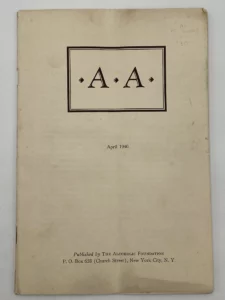
Larry Jewell of the Houston Press
Early AA History Larry Jewell, Houston Press & Early AA Public Outreach THE FIRST “A.A.” PAMPHLET AS DERIVED FROM THE SERIES OF ARTICLES FROM THE HOUSTON PRESS The content inside
24 Hour Helpline 510-839-8900 English 510-502-8560 Espanol Helplines are staffed 24/7 by A.A. member volunteers who have solved their drinking problem.
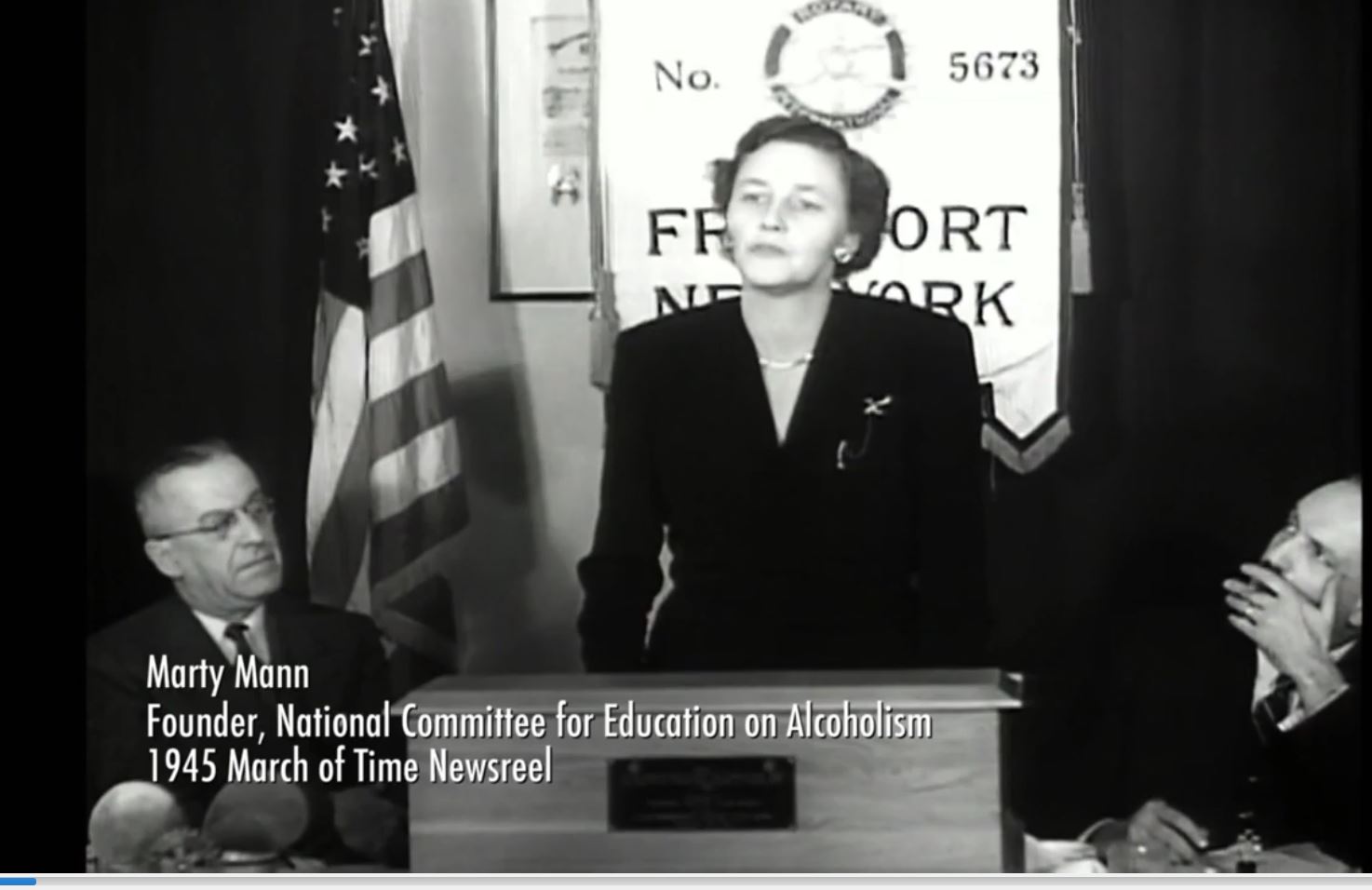
Mr. Chairman, Members of the Economic Club of Detroit and that wider radio audience whom I cannot see: I stand before you here today on behalf of two groups. One group is made of free people, free because they have knowledge. The other group is made up of prisoners, prisoners of their condition, held prisoners by ignorance and fear.
The first group is that whom I officially represent, the National Committee for Education on Alcoholism, made up of men and women of science and medicine of the clergy and of the arts, of business and of public life who are aware of the nature of this problem and who are determined to do something about it.
They have done me the honor of appointing me Executive Director of that group and have made me the spokesman for their program.
The other group has not appointed me. The other group is not organized. It frequently does not know there is a group.
These prisoners that I spoke of are the alcoholics of America, three million strong.
Many of them are unaware of their own condition; are unaware of its nature; and are unaware that there is anything whatsoever to do about it.
They did not need to appoint men; I belong to that group. I myself shared their condition of being a prisoner until the truth made me free.
First, I wish to speak to you on behalf of the National Committee for Education on Alcoholism. Later, I am going to speak to you on behalf of that other group who needs our help.
The National Committee for Education on Alcoholism is exactly what its name implies. Our objectives are implicit in that title. We are interested solely in giving the public the true facts about alcoholism, its nature and treatment, in order that they may have the weapons of knowledge with which to effect a solution of this terrible and growing problem. We are not dealing here with a minor problem. We are dealing with what an Assistant Surgeon General of the United States Public Health Service has rightly called “Our greatest unsolved public health problem.” It is not unsolved because it is a new problem. Indeed, it has been with us from the beginning of time. It remains unsolved because it is a problem we have never faced. It is something we have never even discussed. The majority of people in their ignorance and fear scarcely admit of its existence. Alcoholism has for too long been a taboo subject; just as tuberculosis used to be forty years ago. It has been hidden under a dark cloud of stigma, made darker by fear of that stigma. Any child can tell you that no problem can be solved by refusing to recognize its existence. Equally true is the fact that no problem can be solved while unaware of its nature.
Then for the first time, alcoholics began to get well in numbers. They were banded together in groups and together they had the strength to face the hostile world and to talk of this illness from which they had recovered. They talked so that other alcoholics might learn the truth about their condition, and seek help. Their voices were heard. Today, Alcoholics Anonymous numbers more than 30,000 active members; well and happy people; prosperous citizens who have returned to their places in their communities; who are assets – no longer liabilities. These people make good citizens –these same people, who a few years ago were a stone around the neck of everyone who knew them; A care and a burden and a terrible cost to themselves, their families, their employers and their communities. Liabilities in every sense, they represented not only appalling economic waste, but also the most terrible human waste; heartbreak, broken homes and tragedies of very
sort. Yet today they are assets. They can be seen and they are known for their accomplishments throughout the length and breadth of the land. They are the living proof of the second concept. No one any longer can say as I myself once said and as we all were taught, that the drunkard is a bum for whom there is no hope because there is something vital missing in him – he has no willpower, no character – or he would not let himself get that way. These people know that they have a disease of which they need be no more ashamed than if they happened to have diabetes or T.B. On the contrary, they can be proud of the fact that in spite of suffering from a progressive and often fatal malady for which there is no absolute cure, they have learned how to arrest their illness so that they can lead normal, healthy, happy lives.
Our last concept, that this is a public health problem and therefore, a public responsibility, follows inevitably upon acceptance of the other two. This is our job, yours and mine, as citizens and as human beings. We, the people, create public attitudes – and we can change them. Our first job is to change this attitude, for until that is done alcoholics and their families will not seek help. The majority of the estimated 3,000,000alcoholics in this country fall into the category of what I call the hidden alcoholic. These are usually people who have some family left, and that family will go to any lengths to see that no one knows that the stigma of alcoholism has struck in their midst. In their opinion, the shame and degradation of
having this fact become common knowledge far outweighs the welfare of the alcoholic. The alcoholic is “protected,” hidden from view, but actually he is prevented from getting help. Not until the stigma is removed and alcoholism is discussed as freely and openly as any other illness, will these people dare to seek help. We must remove this stigma if we are to save thousands from unnecessary deaths.
But we must do more than this, for in many cases there will be no facilities for the treatment of some of these people. All of them may not be suitable for A.A. All of them may not be willing or ready to accept that particular method of treatment, and there are other methods which have also helped alcoholics back to normal life; psychiatry, lay therapy, the conditioned reflex treatment. Unfortunately the last three are both long and expensive – too often beyond the reach of the alcoholic and his family.
Nevertheless each method has its record of success. None of these methods are infallible. And in this illness it has been found that on occasion a combination of several methods of treatment will sometimes succeed in the most difficult and apparently hopeless cases.
Many groups have been concerned for many years with the beverage alcohol. Millions of words spoken and written on behalf of hundreds of organizations have dealt with this. In the last analysis this concern has resolved itself into a violent tug of war between the “wets” and the “drys.” In that tug of war it has been said that the alcoholic has been the rope – and that rope has become badly frayed. No organization until very recently has concerned itself with the plight of the alcoholic or the nature of his dilemma. That is where the National Committee comes in.
The National Committee is not concerned with the problem of beverage alcohol. We take no side in that ancient tug of war. We state flatly in fact that this organization, the National Committee for Education on Alcoholism and all of its affiliated Committees -eighteen of them at this date – are neither “wet” nor “dry.” We go further. We state that this organization shall not concern itself in any activities designed to promote or prevent the sale or consumption of alcoholic beverages. Our concern is with a disease called alcoholism and its victims, those hapless, suffering human beings who are known as alcoholics.
We recognize, as did others concerned with the problem of alcoholism, that practically nothing was known by the general public of this disease. We realize that because of this lack of knowledge, the public attitude ranged from utter ignorance, through apathy and indifference, up to prejudice and active antagonism. The public attitude reflects not only a total lack of factual knowledge, but the presence of a mass of misinformation and falsehoods. Out of this attitude has grown the type of treatment which the citizens of these United States have given and still give to that segment of the population -their helpless fellow citizens – who suffer from this illness. I think you all know what that treatment is as well as I do. It is hostile, contemptuous, and punitive. It is completely without understanding and often without pity.
In most cities in this country there is nowhere to put the alcoholic who is in the throes of this deadly malady, excepting the local jail. We, as a nation, are not wont to treat our sick in this fashion. We are not cruel and barbarous. We are not medieval. We pride ourselves on being enlightened, and we are, on the whole, a kind people. And yet to a great body of very sick human beings we offer only punishment for their illness. We behave as if we were still in the Middle Ages.
This situation must be changed. It is our belief that it will be changed when the public is placed in possession of the facts. That is the challenging task which we have accepted. We wished to make these facts as simple and understandable as possible that they might be understood by every man, woman and child in this country. In order to do that, we adopted three simple concepts which are printed on each piece of our literature, and which our speakers reiterate over and over again throughout the cities of this land. They are simple, these concepts, but they are revolutionary in content., for they embody an attitude which is exactly the opposite to that shown by our actions in the past, and I am afraid I must add, in the present. We believe that when these concepts are accepted into the thinking of the people of America a change in their actions must result. We believe that repetition will help to implant these concepts in the mind of the public, and so they are embodied – in fact, they form the basis of every talk that is given on behalf of the National Committee. The three concepts are as follows:
One, Alcoholism is a disease and the alcoholic is a sick person.
Two, the alcoholic can be helped and is worth helping.
Three, alcoholism is a public health problem and therefore, a public responsibility.
Perhaps these do not appear revolutionary on the surface, but stop and think of the associations we all have been taught to have with the words disease and sickness. We know, for instance, that disease is no respecter of persons; it can strike anywhere, high or low, rich or poor, men or women. We do not punish sick people for being sick; we treat them. We go to great lengths to establish treatment facilities and they are the pride of our communities. We do not blame sick people for their condition, even when, as often happens, it is brought on by ignorance or carelessness or both. Once they are sick, however this came about, we want them to have the kind of treatment that will help them to get well. It would never occur to us to put a man with malaria in jail – as if to say to him, “you see what this does to you – now let that be a lesson to you and don’t let it happen again.” We know that he is sick, he is rarely capable of self-treatment. We know that he needs help – to overcome his illness. Put these simple associations beside our behavior toward those sick people who are sick with alcoholism and you will see how revolutionary that concept is.
The fact that alcoholism is a disease has been known to science for over 150 years. Many great Americans of the last century recognized this fact, although it was an English doctor who wrote the first modern treatise on the diagnosis and treatment of the disease of alcoholism in 1778.
Our own Connecticut Medical Society recognized alcoholism as a disease requiring special treatment and hospitals for that treatment in a resolution it presented to the Connecticut State Legislature in 1830. I myself was ashamed when I learned these things, and yet it was not my fault, for I had never been taught any such facts. Just the same, it is curious, is it not, that scientific facts well known to science over such a long period should never have become common knowledge? The normal gap, they tell me, between a scientific discovery and its acceptance by the public, before which of course, it cannot be of real use, is twenty years. Why should this gap be so extended? We are late in starting, but we are trying desperately to bridge that gap as speedily and as effectively as possibly now. This, in short, is our primary objective.
Our second concept, that the alcoholic can be helped and is worth helping is a statement that could not have been made even ten years ago from a public platform, because it could not have been proved. Although there have always been alcoholics who got well by one means or another and walked among us as normal human beings, they dared not mention what the nature of their illness had been. The stigma which had been attached to alcoholism was so great that if people knew the truth, these recovered alcoholics might have jeopardized their whole future – their jobs, their family relationships, their places in society, everything that makes life most dear. Not until the creation of Alcoholics Anonymous twelve years ago was there any change in the situation.
Then for the first time, alcoholics began to get well in numbers. They were banded together in groups and together they had the strength to face the hostile world and to talk of this illness from which they had recovered. They talked so that other alcoholics might learn the truth about their condition, and seek help. Their voices were heard. Today, Alcoholics Anonymous numbers more than 30,000 active members; well and happy people; prosperous citizens who have returned to their places in their communities; who are assets – no longer liabilities. These people make good citizens –these same people, who a few years ago were a stone around the neck of everyone who knew them; A care and a burden and a terrible cost to themselves, their families, their employers and their communities. Liabilities in every sense, they represented not only appalling economic waste, but also the most terrible human waste; heartbreak, broken homes and tragedies of very sort.
Yet today they are assets. They can be seen and they are known for their accomplishments throughout the length and breadth of the land. They are the living proof of the second concept. No one any longer can say as I myself once said and as we all were taught, that the drunkard is a bum for whom there is no hope because there is something vital missing in him – he has no willpower, no character – or he would not let himself get that way. These people know that they have a disease of which they need be no more ashamed than if they happened to have diabetes or T.B. On the contrary, they can be proud of the fact that in spite of suffering from a progressive and often fatal malady for which there is no absolute cure, they have learned how to arrest their illness so that they can lead normal, healthy, happy lives.
Our last concept, that this is a public health problem and therefore, a public responsibility, follows inevitably upon acceptance of the other two. This is our job, yours and mine, as citizens and as human beings. We, the people, create public attitudes – and we can change them. Our first job is to change this attitude, for until that is done alcoholics and their families will not seek help. The majority of the estimated 3,000,000 alcoholics in this country fall into the category of what I call the hidden alcoholic. These are usually people who have some family left, and that family will go to any lengths to see that no one knows that the stigma of alcoholism has struck in their midst. In their opinion, the shame and degradation of having this fact become common knowledge far out weighs the welfare of the alcoholic. The alcoholic is “protected,” hidden from view, but actually he is prevented from getting help. Not until the stigma is removed and alcoholism is discussed as freely and openly as any other illness, will these people dare to seek help. We must remove this stigma if we are to save thousands from unnecessary deaths.
But we must do more than this, for in many cases there will be no facilities for the treatment of some of these people. All of them may not be suitable for A.A. All of them may not be willing or ready to accept that particular method of treatment, and there are other methods which have also helped alcoholics back to normal life; psychiatry, lay therapy, the conditioned reflex treatment. Unfortunately the last three are both long and expensive – too often beyond the reach of the alcoholic and his family.
Nevertheless each method has its record of success. None of these methods are infallible. And in this illness it has been found that on occasion a combination of several methods of treatment will sometimes succeed in the most difficult and apparently hopeless cases.
So our efforts cannot stop with a mere change in public opinion. We must organize to change the conditions which that public opinion has brought about. We must see to it that there are other places than jails in which to put these sick people when they are in the delirium of their sickness – acute intoxication. We must set up information centers where individuals and family and friends – agencies that are forced to handle their problems – doctors and ministers who usually see more of it than anyone else — can go to get the facts on the disease itself, and on the facilities available in that area for its treatment. These centers must ceaselessly carry on an intensive campaign of education in their communities, aimed at uncovering more and more hidden alcoholics and also at providing an environment of enlightened understanding in which the process of recovery will be possible.
Every community will find that there are not many facilities other than the local group of A.A. about which they can give information; and yet other facilities will be needed. Therefore, these organized groups (which we must call local committees of the National Committee) must next undertake the difficult task of persuading general hospitals to open beds for the treatment of alcoholics in the acute stage. This I might add, is a matter of crisis – of extreme emergency – in which the lack of immediate medical treatment all too frequently causes death. Next, they will need a clinic for diagnosis and treatment and later they will need rest centers for those who require long-term care.
It is no longer necessary to say that we believe – we can now say that we know that this program of community action is a beginning toward the solution of this problem which is so appalling in its devastation and waste. We can say we know because we already have eighteen such affiliated committees operating in eighteen cities throughout the country, and the progress they report is more than encouraging. It has convinced us that we can solve the problem of alcoholism in America – and we will.
Now I can go back to my regular method of speaking. I am strictly an extemporaneous speaker; I am not used to reading a speech; but with all the national hook-ups on the radio, I thought I had better.
I want to talk to you a little bit now about the second group which I said I represented. The unnamed, the nameless, the alcoholics. I would say that perhaps ninety per cent of them have no idea what their trouble is. You know, the alcoholic is a part of the public. The attitude that I have described to you which the public holds is shared in by those people who suffer from this illness. I can tell you this from my own experience. I had never heard the word alcoholic; I had never heard the word alcoholism. Of course, I had heard of drunkards; everybody has. I also knew or thought I knew what a drunkard was. He was that unfortunate person that one saw if one went to the less pretty part of town, shuffling about in rags, bearded, unwashed, sleeping in doorways, in gutters, sticking out filthy hands for a dime for a cup of coffee and you hoped he wouldn’t touch you.
If I had given any thought to the subject I would have described that person as a person who had never had a chance, or the opportunity to know the normal way of life, and who, if he had been born to better things, had something missing, something that made him unable to take advantage of his opportunities. I would have said that there was nothing that could be done about it, and if there was he wouldn’t be worth salvaging as there wasn’t anything there in the first place.
I might have conceded that there were a few localized cases in which some terrible tragedy had driven the person to drink – to drown his sorrows in drink, but I actually that was pretty well confined to the pages of romance literature. That is all I knew about it.
I think you will understand then that when this thing began to happen to me it was simply not possible for me to identify myself with that picture. How could someone with my background, with my upbringing, with my education, how could someone like that have this happen. Oh, no, it couldn’t happen here.
Another thing I knew (and anyone who knew me could testify) was that I had been afflicted with a little too much of that commodity known as will power, in my case called willful. I had always gotten what I went out for. I had achieved quite a bit in my life. I had never suffered from any lack of will power or lack of character either. And those attributes were not a part of the picture that I had. This person, this drunkard, had no will power, no spine, no backbone, no character.
When these things began to happen to me, it had to be something else, it could not be that. It had to be some terrible mental collapse since, obviously, I could not even look in that direction. I could not say, “this is me.”
There you have the problem with a great many of the alcoholics. How can they admit to this thing with their perverted and prevalent conception of what this thing is? How can a man who still has a job or has only just lost his job through drinking come out openly and say: “I am a drunkard; I have no will power; I have no character; I am a bum?” He isn’t and knows he isn’t. He is faced with the same dilemma in which I found myself. Why is it that my will power is so strong on every- thing else and has no effect on drinking. Why can’t I answer when my friends say to me, “Why can’t you be like other people and drink sensibly,” “Why can’t you drink like so and so; I made every effort to take one or two and stop; but it was just like butting my head against a stone wall.
That wall was the wall of ignorance and the wall of prejudice. It nearly killed me, and it is killing other alcoholics every day
If we can break that wall down we can reach these people and we can help these people. A program of community action such as I described briefly will do that job. In every one of the cities where this program is inaction more and more alcoholics come forward and ask for help. In every city where we have information centers they are coming and asking for this information and their families and’ friends and employers are coming. They are all asking, “What is this thing, alcoholism,” “What can we do about it;” “Where can we go in this city for help?” And centers that have been established and the members of the Committee that set up those centers are aware of their needs and they have the answers for them: what hospitals will take alcoholics; are there any in the community; can we persuade them to take alcoholics in; can we at long last provide something for these desperately sick people. Can we provide medical treatment that will prevent their deaths? Yes, we can, and we must.
I want to establish here before I leave Detroit such a Committee as has already been started. I want to see the attempt made at community action. I believe that it can succeed and I believe that when all of these cities in this Country put this plan into action we will see in front of us the possibility of controlling the disease of alcoholism.
The thing we are attempting to do is not so very difficult – it is not very different from what we had to do on a national scale forty years ago with T B. That was the primary killer then; that was the stigma then; that was the thing that no family would admit to having. They were so careful that no one should know, that people with T B died like flies from lack of treatment. Then an intensified campaign was put on…of education and the setting up of proper facilities. Now the White Plague T B is at last under control and we no longer regard it as the stigma it was. We can do the same for alcoholism but we must put not only moral support but financial support behind this effort. We must see that these things are done that will repay us a thousand fold.
I know by virtue of my own position as an alcoholic thousands of men and women who have recovered from this illness. I can assure you from my personal experience that these people make better than average citizens. It is as if they felt they had to make up for lost time. They put themselves into things with twice the amount of energy of anyone else. They work harder at it and they give more of themselves. These people are well worth saving and yet today we are allowing them to die right and left.
We know, for instance, that every year 12,000 people die with alcoholism put on their death certificates as the primary or secondary cause of death. We know also that that must be but a fraction of the actual deaths for we know that wherever the family is still there they will go to any lengths to see that those grim words are not put on the death certificates. These people do not need to die. That great loss that you heard Dr. Jellinek describe does not need to go on. All of this unnecessary waste we can stop. We can stop it first, by changing our own attitude, next by trying to change the attitude of everyone else we know, presenting them with these simple concepts, asking them to think them over and then to act on them. We can top it by setting up Committees such as I have described and by making great efforts to provide facilities for our cities. Those are the steps we need to take; those are the steps I hope you will take here.
My visit to Detroit has not been just to speak to you gentlemen, as great as that pleasure has been and deeply as I feel the honor of appearing before you as a woman. I understand that is a very rare occasion here. The real purpose of my visit is to put a piece of dynamite under those who are already interested and try to arouse interest in the rest of you to put into effect a program of community action.
It wouldn’t do much good if I came and went and you talked about it for a few days and then other concerns came up and you forgot about it. No, We want something to go on; we want continuity in the program; we want results.
I am convinced that we can have in Detroit our most effective Committee for Education on Alcoholism if all of you present will help out.
Source: Vital Speeches of the Day © , Vol. 13(8), 253-256, February 1, 1947.

Early AA History Larry Jewell, Houston Press & Early AA Public Outreach THE FIRST “A.A.” PAMPHLET AS DERIVED FROM THE SERIES OF ARTICLES FROM THE HOUSTON PRESS The content inside

“Sobriety — freedom from alcohol —through the teaching and practice of the Twelve Steps, is the sole purpose of an A.A. group. Singleness of Purpose Sobriety — freedom from alcohol
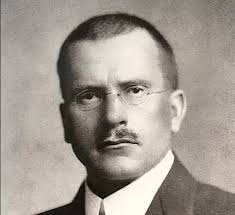
The letters between Bill W. and Dr. Carl Jung The following letter was written by Bill Wilson to the eminent Swiss psychologist & psychiatrist Dr. Carl Gustav Jung, dated 1/23/61.
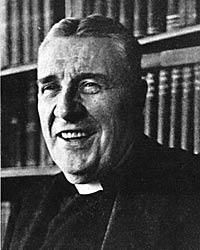
Sam Shoemaker Shoemakers early influence on AA. Sam Shoemaker, an Episcopal clergyman, played a pivotal role in the early development of Alcoholics Anonymous (AA). Born on December 27, 1893, in
Bill Wilson’s 1944 Alcoholics Anonymous holiday message To all AA members, Greetings on our 10th Christmas, 1944. Yes, its’ in the air! The spirit of Christmas once more warms this
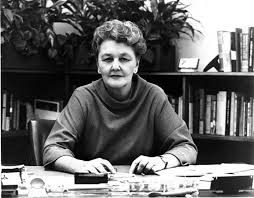
Mrs. Marty Mann Speaks Marty Mann: First Lady of Public Information ALCOHOLICS ANONYMOUS by MRS. MARTY MANN, New York, N.Y. Executive Director, National Committee for Education of Alcoholism, Sponsored by
The primary purpose of East Bay Intergroup, Inc. is to help inform the greater community about AA and alcoholism so that those who need help
can find recovery from alcoholism.
East Bay Intergroup is an organization created and sustained by AA groups in the San Francisco East Bay.
| Cookie | Duration | Description |
|---|---|---|
| cookielawinfo-checkbox-analytics | 11 months | This cookie is set by GDPR Cookie Consent plugin. The cookie is used to store the user consent for the cookies in the category "Analytics". |
| cookielawinfo-checkbox-functional | 11 months | The cookie is set by GDPR cookie consent to record the user consent for the cookies in the category "Functional". |
| cookielawinfo-checkbox-necessary | 11 months | This cookie is set by GDPR Cookie Consent plugin. The cookies is used to store the user consent for the cookies in the category "Necessary". |
| cookielawinfo-checkbox-others | 11 months | This cookie is set by GDPR Cookie Consent plugin. The cookie is used to store the user consent for the cookies in the category "Other. |
| cookielawinfo-checkbox-performance | 11 months | This cookie is set by GDPR Cookie Consent plugin. The cookie is used to store the user consent for the cookies in the category "Performance". |
| viewed_cookie_policy | 11 months | The cookie is set by the GDPR Cookie Consent plugin and is used to store whether or not user has consented to the use of cookies. It does not store any personal data. |